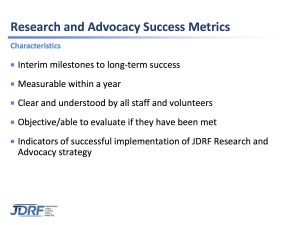Today I have a something/someone special to share. It’s a guest post from my friend Sara who was one of the first people I met and felt I could really talk to when I made the switch from MDI to an insulin pump in 2000 (we also happened to have the same doctors). I can’t possibly explain how fortunate I felt to have her as a friend then and all these years later, for her friendship now (hey, when she got her Dexcom she was willing to to bedazzle it). Sara’s friendship has been a true resource for me and made me realize how important it is to have peer support. She moved to AZ many years ago, but I usually get to see her twice a year when she’s in NYC on work trips. She is a friend I probably never would have met if it weren’t for T1D. So yes diabetes, I will give you 1 point for that one. Here’s her post (Also that is a pic of us below, post pumpkin pancakes. Clearly pumpkin pancakes are exhausting hence the squinty eyes):
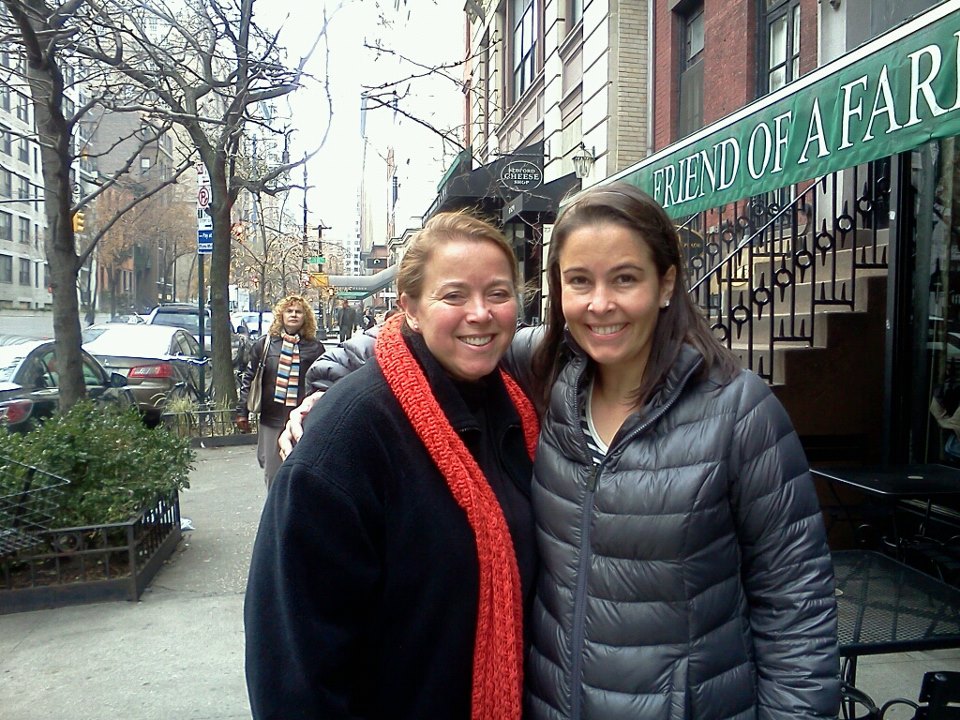
Hi, my name is Sara and I have had type 1 diabetes since I was a little kid and for the last 39 years, 3 months, 16 days and….6 hours, I have been waiting….eagerly, sometimes not so patiently, but always hopefully, for my cure. For the day when I can travel without getting groped by the TSA, and when I can eat, without doing MATH. For the day I stop poking holes in my body and I stop worrying about needing dialysis or going blind or wondering if my brothers kids will get this cruddy disease.
I had the honor of being selected to participate in the first
JDRF T1D Voices Council. These 16 people are meant to reflect the needs of people with type one diabetes. Most of the Council members have T1D, but there are a couple of family members. Most of us are normal people, but some are medical professionals. We are mostly American, but we have some Europeans who bring their unique perspective to the group. We range in age from a college freshman to a grandparent, but what links us is our commitment to finding a cure for Type One diabetes, and our vested interest in JDRF. We are all active with our local chapters, whether as participants in the Annual Walk, and some of us are on our local Board of Directors. We don’t make any funding decisions; we are simply here to speak as the voice of our peers, to make sure our concerns (
and I mean the universal “our,” not just our 16 voices) are being addressed, and to offer some perspective from the front, as it were. We have been assured that our opinions are highly valued by the organization, including CEO Jeffrey Brewer and the International Board of Directors.
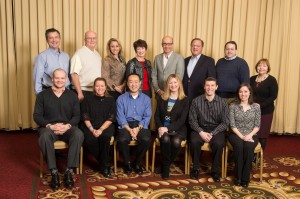
Our first meeting was held last December in conjunction with the research meeting. We all met for the first time in person (we had set up a Facebook page and were stalking each other madly), along with with our leaders, Bill Parsons, from the International Board of Directors and father of a T1D son, and Dr. Richard Insel, JDRF’s chief scientific officer. Our discussion focus was “complications”and specifically, which complications, if any, should JDRF be concerned with in terms of research. As you can imagine, our opinions were fiercely personal; colored by our experiences. For me, the focus should be on eyes, absolutely. Others were more concerned with nighttime lows (the parents in the group seemed to speak loudest on this, less of a concern for me, thanks to my CGM), but we discussed and ranked them. The discussion at times was heated, to say the least, and a couple of us were unable to “rank” which complications were more deserving of funding than others. By the end, however, I think our consensus was that we wanted JDRF to stay focused on a cure and improving our lives, and leave the research on complications to other organizations. One complication the T1D VC discussed, which wasn’t on the original list, were the psychological aspects of living with this disease, which I think came as a bit of a surprise to the powers that be.
Two weeks ago, the T1DVC attended the annual conference in Washington DC, and we were forewarned that our topic was going to be the Psycho-Social aspects of T1D, which arose partially from a recent study on these issues, and our timely discussion back in December. However, let me start by saying for the first time in 39-odd years, I finally really felt some HOPE….sure, we all say we are full of HOPE every year when we try to raise money for the Walk…my donors need to hear that I haven’t given up on JDRF. Frankly, that “just around the corner” nonsense has been playing rather thin. But now, oh, NOW! I am so full of ever-lovin’, say Hallelujah, pass the hat HOPE, I can’t stop bouncing, dare I admit to smiling, (and then crying) every time I talk about it.

Little Sara
Not much has changed since the research meeting in terms of what JDRF is pushing through the pipeline (as they like to phrase it), but what HAS changed is the marketing and presentation of this research. For eons, I have had issue with the way JDRF marketed us! I was just sick of the ads full of cute children surrounding Mary Tyler Moore, as she begged for a cure. Don’t get me wrong, I LOVE Mary Tyler Moore, but she is not of this generation, and while Nick Jonas and Halle Berry ARE, we can’t seem to get them to speak out as loudly as, say Christina Applegate and Sheryl Crow do for breast cancer.
Anyway, enough whiny rant. The point is, if you haven’t seen the new marketing campaign, stop reading now and go watch the
BELIEVE video (
which got a standing ovation and reduced me to tears) and the
VISION video (
which also got thunderous applause and reduced me to tears), and then watch the research videos on
Encapsulated Beta Cells and the
Artificial Pancreas Project and
Smart Insulin and the
WALK video or watch the
Plan for the Future one. If you aren’t moved by these, then you probably aren’t really T1D!
So then we had our T1DVC discussion on the psycho-social aspects of diabetes, and we each defined our vision of a “cure.” Some of us are pretty strict and a cure means, “life as it was BEFORE diabetes,” while others are a little more lenient, and would accept a STEP towards a cure, such as encapsulated beta cells, or even an artifical pancreas system that integrated insulin, symlin AND glucagon. Most of agreed we didn’t want to trade T1D for anti rejection drugs and a pancreas transplant.
What I am MOST excited about is those Encapsulated Beta Cells. I won’t go into all the technology behind it cuz you can google
Viacyte and read one company’s plan for yourself, but I SAW it. Jeffrey Brewer stood up there and held up a prototype of this amazing device in his hand. It looks like a tea bag, but this packet will allow us to live completely boring lives, for up to 24 months…which, as Jeff said, isn’t exactly a CURE, but it IS a darn good thing. And it will be in clinical trials next year!
And don’t you think, for one SECOND, that just because they are working on all these technological advances, they’ve forgotten about a CURE. The Voices Council cornered Dr. Insel at breakfast and grilled him on research updates that our own doctors don’t know about. His eyes gleamed as he talked about the things that are coming down the pike…the potential for a vaccine, and regenerating damaged beta cells, and gene therapy. It is all THERE….and we just can’t lose hope!
And basically, it’s that hope that gets us out of bed every morning. It’s why we ask our friends and families to donate to the walk, isn’t it? We all still hope for our cure and we need JDRF to continue this research until we have a world without Type One Diabetes. JDRF is now making it clear that they are no longer a mom and pop organization, but a world leader committed to removing T1D from this earth and until then, it is their mission to lessen our burden, lessen our struggle, lessen our pain and fear, and lessen that of our loved ones.
And they won’t stop, until they turn Type One into Type None
So, now go sign up to be a part of Alecia’s Stem Cells, or come be part of my Team Type None in Tucson, and let’s NOT give up our hope!
Sara (LINK TO MY VIDEO)
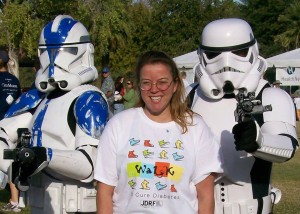
Like this:
Like Loading...
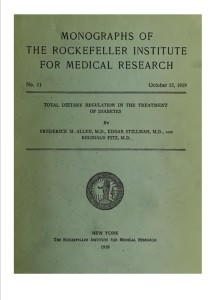 “First, a little history lesson, if you will indulge me. Diabetes has been around a LONG time, first notated by Hippocrates, and on through the ages. A brief history of the disease is included in this monograph published in 1918. At different times, the ailment was thought to be a problem with the kidneys or the liver, or the blood, or the psyche. Proper diagnosis of diabetes became possible in the 1600s when Thomas Willis noted that the “urine is wonderfully sweet, as if imbued with honey or sugar,” as if he was describing a fine wine! The doctors and scientists were determined to find out what caused the fatal dis-function of the body, and endeavored to find better, more effective ways to treat it.
“First, a little history lesson, if you will indulge me. Diabetes has been around a LONG time, first notated by Hippocrates, and on through the ages. A brief history of the disease is included in this monograph published in 1918. At different times, the ailment was thought to be a problem with the kidneys or the liver, or the blood, or the psyche. Proper diagnosis of diabetes became possible in the 1600s when Thomas Willis noted that the “urine is wonderfully sweet, as if imbued with honey or sugar,” as if he was describing a fine wine! The doctors and scientists were determined to find out what caused the fatal dis-function of the body, and endeavored to find better, more effective ways to treat it. 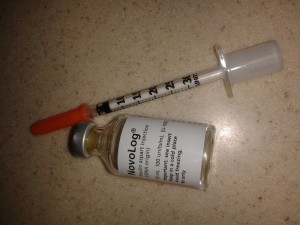 Though i must say this 30 unit syringe with its super fine needle is a lot more palatable than the 100 unit syringe with the pool cue sized needle I first used.
Though i must say this 30 unit syringe with its super fine needle is a lot more palatable than the 100 unit syringe with the pool cue sized needle I first used. 
